Stridulation is the act of producing sound by rubbing together certain body parts. This behavior is mostly associated with insects, but other animals are known to do this as well, such as a number of species of fish, snakes and spiders. The mechanism is typically that of one structure with a well-defined lip, ridge, or nodules being moved across a finely-ridged surface or vice versa, and vibrating as it does so, like the dragging of a phonograph needle across a vinyl record. Sometimes it is the structure bearing the file which resonates to produce the sound, but in other cases it is the structure bearing the scraper, with both variants possible in related groups. Common onomatopoeic words for the sounds produced by stridulation include chirp and chirrup.

Pyrrhocoridae is a family of insects with more than 300 species world-wide. Many are red coloured and are known as red bugs and some species are called cotton stainers because their feeding activities leave an indelible yellow-brownish stain on cotton crops. A common species in parts of Europe is the firebug, and its genus name Pyrrhocoris and the family name are derived from the Greek roots for fire "pyrrho-" and bug "coris". Members of this family are often confused with, but can be quickly separated from, Lygaeidae by the lack of ocelli on the top of the head.
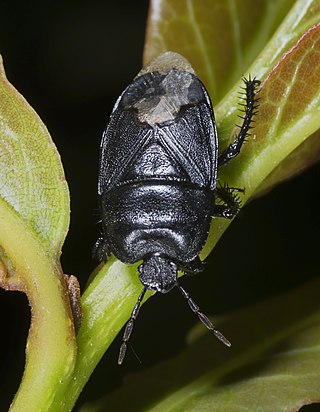
Cydnidae are a family of pentatomoid bugs, known by common names including burrowing bugs or burrower bugs. As the common name would suggest, many members of the group live a subterranean lifestyle, burrowing into soil using their head and forelegs, only emerging to mate and then laying their eggs in soil. Other members of the group are not burrowers, and live above the soil layer, often in close association with plants. Several species are known as agricultural pests.

Velvet water bugs are members of the family Hebridae. They are semiaquatic insects that live among moss or ponds with an abundance of vegetation, in which they prey on small arthropods. Velvet water bugs are the smallest of the Gerromorpha, and have an appearance of tiny veliids. Hebrids sometimes move across water surfaces, but walk or run rather than skate or scull on the surface.

Hydrometridae is a family of semiaquatic insects, known as marsh treaders or water measurers. They have a characteristic elongated head and body which makes them resemble a yardstick for measuring the water surface.

Jadera haematoloma, the red-shouldered bug, goldenrain-tree bug or soapberry bug is a species of true bug that lives throughout the United States and south to northern South America. It feeds on seeds within the soapberry plant family, Sapindaceae, and is known to rapidly adapt to feeding on particular hosts. The species is often confused with boxelder bugs and lovebugs.
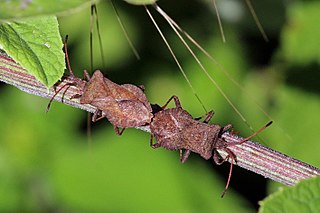
Coreus marginatus is a herbivorous species of true bug in the family Coreidae. It is commonly known as the dock bug as it feeds on the leaves and seeds of docks and sorrels. It is a medium-sized speckled brown insect, between 13 and 15 mm long as an adult, with a broad abdomen. It occurs throughout Europe, Asia and northern Africa. It is often found in dense vegetation, such as hedgerows and wasteland.

Insects in the subfamily Phymatinae are commonly called ambush bugs after their habit of lying in wait for prey, relying on their superb camouflage. Armed with raptorial forelegs, ambush bugs routinely capture prey ten or more times their own size. They form a subgroup within the assassin bugs.

Enchophora sanguinea is a species of lantern bug, a type of hemipteran, found in Central and South America. It was first described by William Lucas Distant in 1887. They are 25 millimetres (1.0 in) long. Their colour varies, but is normally red to green; they have a scimitar-shaped process on their heads. They feed on the sap of trees, most commonly Simarouba amara, and they excrete honeydew out of their anuses.
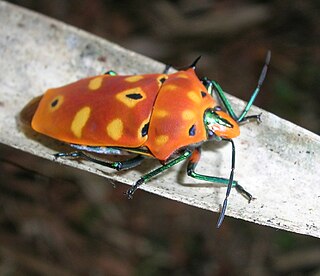
Cantao ocellatus is a species of shield bug in the family Scutelleridae found across Asia.
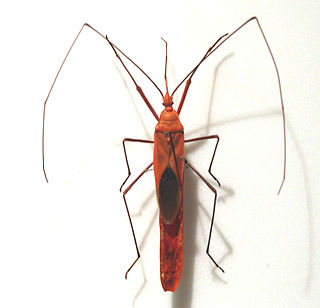
Macrocheraia is a genus of bugs in the family Largidae with a single species, Macrocheraia grandis found mainly in Southeast Asia but extending into parts of South Asia. This was referred to in some older literature under the genus Lohita, a name derived from the Sanskrit word for red.

Gonocerus acuteangulatus is a herbivorous species of true bug in the family Coreidae. It is commonly known as the box bug in the UK as it once only occurred in Box Hill in Surrey where it fed on box trees.

Dinidoridae is a small family of hemipteran "true bugs" comprising about sixteen genera and a hundred species the Hemiptera suborder Heteroptera. As a group the family does not have any common name. Until the late 19th century they were generally regarded as a subfamily of Pentatomidae.
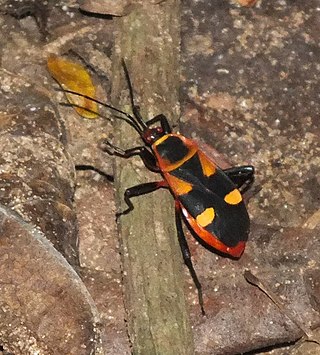
Roscius is an Afrotropical genus of true bugs in the family Pyrrhocoridae, the cotton stainers. They are often confused with bugs in the family Lygaeidae, such as the genus Oncopeltus, but can be distinguished by the lack of ocelli on the head.

Dysdercus is a widespread genus of true bugs in the family Pyrrhocoridae; a number of species attacking cotton bolls may be called "cotton stainers".

Alydus calcaratus is a bug species with a Holarctic distribution ranging from the British Isles almost all over Europe to eastern Siberia and China. Moreover, the species also in northern North America from Alaska and Québec across the United States to Wyoming. It is the only species in the family in northern Central Europe outside of the Alps.

Gerontoformica is an extinct genus of stem-group ants. The genus contains thirteen described species known from Late Cretaceous fossils found in Asia and Europe. The species were described between 2004 and 2016, with a number of the species formerly being placed into the junior synonym genus Sphecomyrmodes.

Kinnaridae is a family of fulgoroid planthoppers. This is a small family with a little more than 20 genera and about a 100 species. The family was erected by Muir in 1925 and most members are found in the Oriental and Neotropical regions and only a few in the Nearctic and Palaearctic regions.
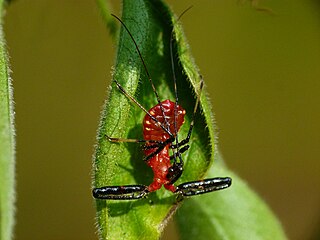
Rihirbus is a genus of assassin bug from the tropical parts of the Oriental region. They belong to the Harpactorinae and the genus is unique in having the fore tibiae with incurved tips and the apex having a long tooth. They show sexual dimorphism and are polymorphic making their identification to species complicated. Females are larger and wider. R. trochantericus takes about 49 days to develop from egg to adult in southern India.

Remaudiereana is a genus of true bugs in the family Rhyparochromidae.



















